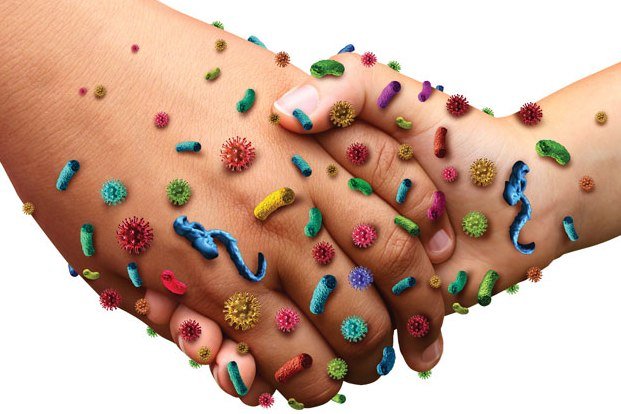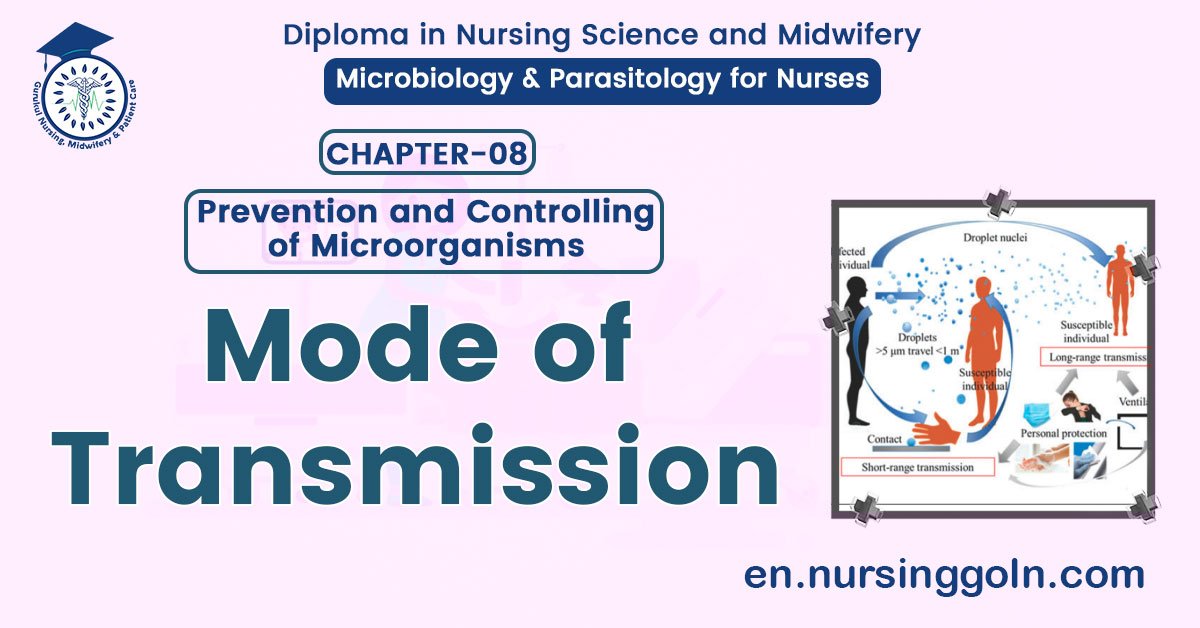Mode of transmission – Basic microbiology, parasitology, and immunology; nature, reproduction, growth, and transmission of common microorganisms and parasites in Bangladesh; prevention including universal precaution and immunization, control, sterilization, and disinfection; and specimen collections and examination. Students will have an understanding of common organisms and parasites caused human diseases and acquire knowledge about the prevention and control of those organisms.
Mode of transmission
Direct Transmission
Direct contact: Infection may be transmitted by direct contract from skin to skin, mucosa to mucosa or mucosa to skin of the same or another person.
- Example: STD and AIDS, leprosy, skin & eye infection
Droplet infection: This is the direct projection of a spray of droplets of saliva and nasopharyngeal secretions during coughing, scenting or speaking and spitting. The sizes of the particles are less than 5 mm and spread is limited to a distance of 30-60 cm between source and hostat.
- Example: Common cold, diphtheria, whooping cough.
Contact with soil: The disease agent may be acquired by direct exposure to the disease agent in soil, compost or clearing vegetable matter.
- Example: Hookworm, larval, tetanus, mycosis etc.
Inoculation into skin or mucosa: The disease agent may be included directly into the skin or mucosa.
- Example: Rabies virus by dog bite, hepatitis B virus through needles and syringes.
Transplancental or vertical: Diseases transmitted through placenta,
- Example: Syphilis, Toxoplasma gondii, Rubella virus, Cytomegalovirus, Herpes virus, Varicella virus, Syphilis, Hepatitis B, Coxsacki-B, AIDS etc.

Indirect Transmission
Vehicle bore:
- Water & food borne: Acute diarrhoea, typhoid fever, cholera, polio, hepatitis A, food poisoning.
- Blood borne: Hepatitis B, Malaria, syphilisena to som tali
- Organ transplantation: Cytomegalovirus infection.
Vector bone:
- Mechanical transmission: Diarrhoea.
- Biological transmission: Plague, malaria.
Air borne:
- Droplet nuclei: They are tiny particles (1-10 microns range) with represent the dried residue of droplets. They may be formed by i) evaporation of droplets coughed or sneezed into air or ii) generated by atomizing devices (aerosols).
Example: TB, influenza, chicken pox, measles.
- Dust: They are larger droplets settle down by their sheer weight on the floor, carpet, clothes and become part of the dust.
Example: TB, pneumonia, Q-fever etc.
- From soil by wind: e.g: fungal spore.
Fomite borne:
Fomites are inanimate articles or substances other than water or food contaminated by the infectious discharges from a patient. Fomites include soiled clothes, towels linen, cups, spoons etc.
Example: Diphtheria, typhoid fever, bacillary dysentery etc.
Unclean hands and fingers:
The transmission takes place both directly and indirectly, son
Example: Typhoid fever, dysentery, hepatitis A and intestinal parasites.
Principle of Control of Communicable Diseases
Controlling the reservoir / prevention of spread:
- Early diagnosis.
- Notification.
- Epidemiological investigation.
- Isolation.
- Treatment.
- Quarantine.
Interruption of transmission of disease: e.g.
- Water treatment / water purification: To prevent water borne diseases e.g. typhoid, dysentery, cholera, gastro-enteritis, hepatitis etc.
- Control of source of infection: Clean practice such as hand washing, adequate cooking, prompt refrigeration of prepared foods and withdrawal of contaminated foods will prevent most food borne illnesses.
- Control of the vector.
- Practice of safe sex.
Protection of susceptible host:
- Immunization (active, passive & passive-active).
- Chemo prophylaxis.
- Non-specific

Levels of Prevention
There are 4 levels of prevention (primordial, primary, secondary & tertiary)
Primordial prevention:
Prevention of the emergence or development of risk factors in countries or population groups in which they have not yet appeared.
- Example: Many adult health problems (e.g. obesity, hypertension) have their early origins in childhood, because this is the time when lifestyles are formed (e.g. smoking, eating habit, physical exercise etc.). In primordial prevention, efforts are directed towards discouraging Children from adopting harmful lifestyles.
- The main intervention în primordial prevention is through individual and education.
Primary prevention:
It signifies intervention in the pre-pathogenesis phase of a disease or health problem (e.g. LBW). There are two modes of intervention in the primary level of disease prevention.
Health promotion: e.g.
- Health education
- Environmental modifications.
- Nutritional intervention
- Lifestyle and behavioral changes
Specific protection: e.g.
- Immunization
- Chemoprophylaxis.
- Protection against accidents. Protection against occupational hazards
Secondary prevention
It may be defined as “action, which halts the progress of a disease at its incipient stage and prevents complications.”
1. The specific interventions are early diagnosis and adequate treatment.
2. The methods employed for early diagnosis are –
- Case finding measures, individual & mass.
- Screening surveys.
- Surveillance techniques.
- Periodic examination.
- Selective examination of people at high risk.

Tertiary prevention
It may be defined as “all measures available to reduce or limit impairments and disabilities, minimize suffering caused by existing departures from good health and to promote the patient’s adjustment to irremediable conditions”. There are two modes of intervention in tertiary level –
1. Disability limitation.
2. Rehabilitation.
- Medical rehabilitation
- Vocational rehabilitation
- Social rehabilitation
- Psychosocial rehabilitation
Read More….
